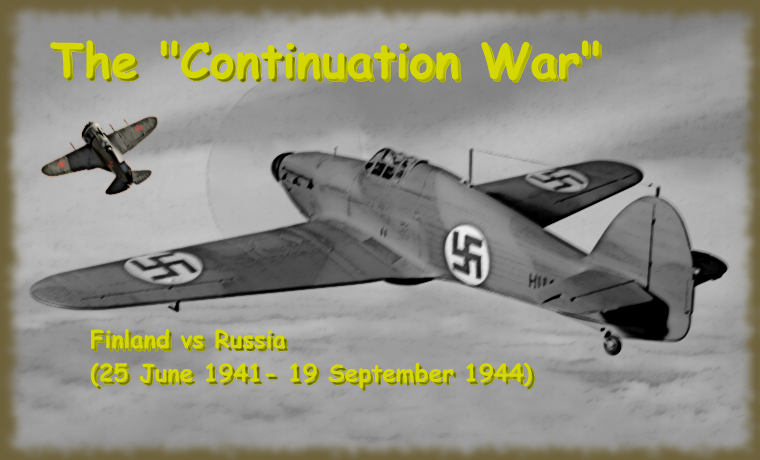Continuation War
The Continuation War (jatkosota, fortsättningskriget, 25 June 1941 – 19 September 1944) was the second of two wars fought between Finland and the Soviet Union during World War II.
At the time of the war, the Finnish side used the name to make clear its perceived relationship to the preceding Winter War. The Soviet Union saw the war as a part of its struggle against Germany and its allies, the Eastern Front of World War II or, as it was known in the Soviet Union, the Great Patriotic War. Germany saw its operations in the region as a part of its overall war efforts of World War II. It provided critical material support and military cooperation to Finland. The United Kingdom declared war on Finland on 6 December 1941, followed by its dominions shortly afterwards. The British declaration of war on Finland during the Continuation War is a rare case of democracies declaring war on other democracies, although no hostilities ensued between the two parties. The United States, like many other nations, did not fight or declare war against Finland.
Acts of war between the two countries started on the day on which the German invasion of the Soviet Union was launched, 22 June 1941. Open warfare began with a Soviet air offensive on 25 June 1941. Subsequent Finnish operations undid its post-Winter War cessations on the Karelian Isthmus and Ladoga Karelia and captured East Karelia by September 1941.
======================================== Early war
On 3/28/1942 a flight of six Curtiss Hawk 75A (CU) fighters from LLv.32 led by Lt. P. Nurminen were protecting the conquer parade of Suursaari island on the Gulf of Finland. During the parade another CU flight of six planes led by Lt. J. Arnkill was alarmed to help intercepting three approaching Soviet formations of a total of 29 Polikarpov I-153 and I-16 fighters. Finns attacked Soviet fighters east from Suursaari island after which aerial combat reigned about an hour. During the dogfight 10 I-153s and seven I-16s were shot down without own losses. Soviet planes could not reach the island and parade was not disturbed.
On 4/6/1942 a flight of eight Finnish Brewster B-239 (BW) fighters led by Lt. L. Pekuri which were returning from a reconnaissance mission met a formation of seven Soviet Ilyushin DB-3 and Petlyakov Pe-2 bombers escorted by 18 Hawker Hurricane II and Lavochin LaGG-3 fighters over Tiiksjärvi (East Karelia). During the combat Finns shot down two DBs and 12 Hurricanes without own losses.
======================================== Setup
[feb 25 - Feb 28]Finland:Brewster B-239
Hurri I
p-40b (sub for Curtiss Hawk 75A)
Russia:I-16
Hurri I(sub for hurri IIB)
======================================== Mid war
In the beginning of 1943, No. 24 Sqn was down to 24 operational Brewster fighters. At the same time, a new unit was formed. No. 34 Sqn was formed to incorporate the new Messerschmitt Bf-109 fighters. It also recruited the best pilots from other units, among them many of No. 24 Sqn's best pilots, i.e. Ilmari Juutilainen and Jorma Lukkanen, who had 34 and 14.5 victories respectively. The Soviet Air Force was continuously modernized. The No. 24 Sqn participated among other in the defence of the Gulf of Finland, where they met the aircraft of the Soviet Baltic Fleet, who recently had mounted an offensive. Captain Hans Wind received the Mannerheim Cross on July 31, when he reached 31 victories.
======================================== Setup
[feb 28 - Mar 2] additionsFinland:109-g2
ju-88
Russia:p-40E
yak-9T
a-20
======================================== Late war
In early 1944 No. 24 Sqn received the "fighter" prefix to its name and only 17 Brewsters remained operational. The successful aircraft, with a 30:1 victory ratio was replaced with Bf 109s. The unit was fully re-equipped by May 1944 and operated 14 Bf 109Gs when the Soviet Great Offensive started
======================================== Setup
[Mar 2 - Mar 3]additionsFinland:109-g6
Russia:p-39Q
la-5FN